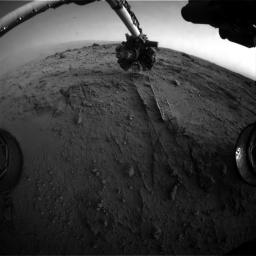
|
Curiosity Uses X-ray Instrument’s Data for Proximity Placement
- Click the image above for a larger view
- Full-Res JPEG (1024 x 1024) (115.4 kB)
- Full-Res TIFF (1024 x 1024) (1.1 MB)
Caption:
NASA's Mars rover Curiosity used a new technique, with added autonomy for the rover, in placement of the tool-bearing turret on its robotic arm during the 399th Martian day, or sol, of the mission. This image from the rover's front Hazard Avoidance Camera (Hazcam) on that sol shows the position of the turret during that process, with the Alpha Particle X-ray Spectrometer (APXS) instrument placed close to the target rock.
The technique, called proximity placement, uses the APXS as if it were a radar for assessing how close the instrument is to a soil or rock surface. The rover can interpret the data and autonomously move the turret closer if it is not yet close enough. This will enable placement of the instrument much closer to soil targets than would have been feasible without risk of touching the sensor head to loose soil or needed extra days of having team members check the data and command arm movement in response.
The location is at "Darwin," inside Gale Crater, where the rover stopped for several days to examine outcrop along the route to Mount Sharp.
Background Info:
NASA's Jet Propulsion Laboratory, Pasadena, Calif., manages the Mars Science Laboratory Project and the mission's Curiosity rover for NASA's Science Mission Directorate in Washington. The rover was designed and assembled at JPL, a division of the California Institute of Technology in Pasadena.
More information about Curiosity is online at http://www.nasa.gov/msl and http://mars.jpl.nasa.gov/msl/ .
Cataloging Keywords:
| Name | Value | Additional Values |
|---|---|---|
| Target | Mars | |
| System | ||
| Target Type | Planet | |
| Mission | Mars Science Laboratory (MSL) | |
| Instrument Host | Curiosity Rover | |
| Host Type | Rover | |
| Instrument | Hazard Camera (Hazcam) | |
| Detector | ||
| Extra Keywords | Crater, Grayscale, Radar | |
| Acquisition Date | ||
| Release Date | 2013-09-23 | |
| Date in Caption | ||
| Image Credit | NASA/JPL-Caltech | |
| Source | photojournal.jpl.nasa.gov/catalog/PIA17363 | |
| Identifier | PIA17363 | |
